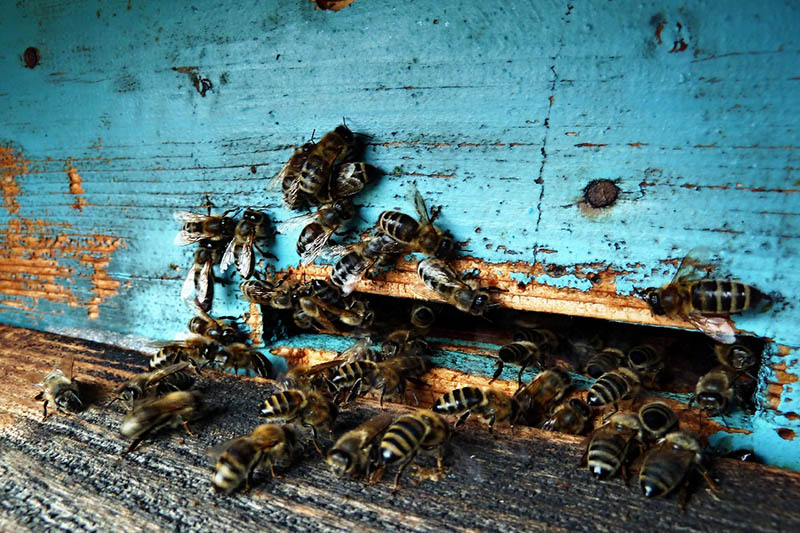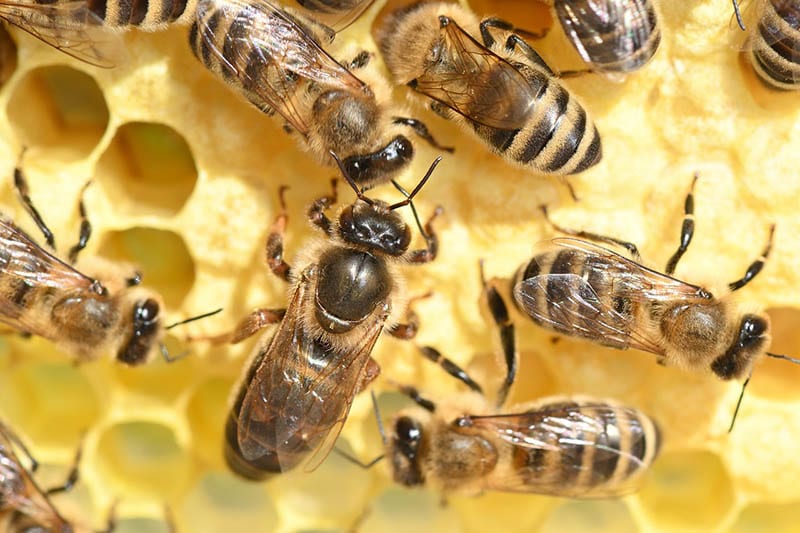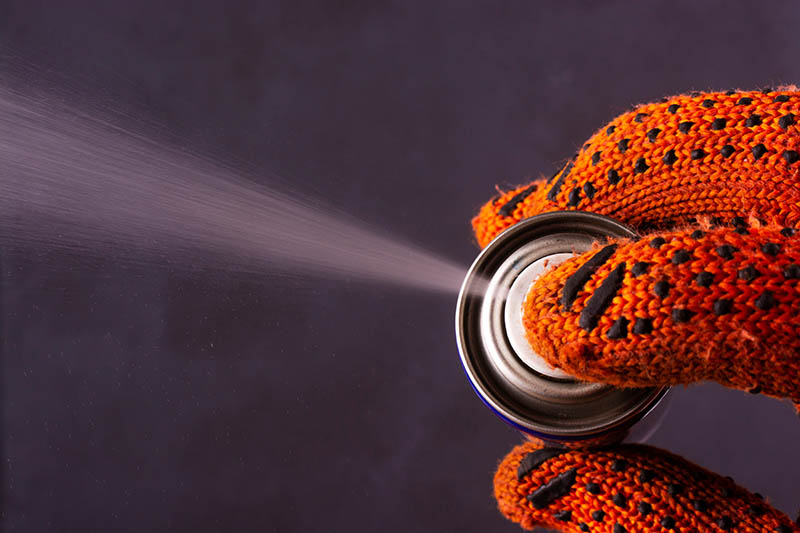Does WD-40 Kill Bees? Uses, Alternatives, & FAQ
-

- Last updated:

If you are into DIY stuff or just like to keep your property in order, we bet you’ve already used WD-40 once or twice. It does a great job of loosening stuck metal parts, protecting gear/equipment from corrosion, and removing grease. But that’s not all it can do! While WD-40 is a lubricant and degreaser at heart, it’s also an efficient bee killer.
That’s right! This spray is deadly to many insects! So, if you’ve got a big nest on your property but don’t want to pay a pro to handle it, this best-selling formula can serve as the perfect remedy. How effective is it, though? Is it toxic to humans and pets, or not? What are the alternatives? Let’s find out!

What Is WD-40? How Does It Work?
WD-40 is one of those all-in-one kinds of products that appeal to a wide range of customers. It consists of carbon dioxide, Vaseline, baby oil, decane, nonane, various alkanes, and other chemical substances. On the one hand, it’s penetrating oil (highly efficient against squeaks). On the other hand, it’s proven to be effective at removing rust from garden tools, car parts, and expensive equipment.
It helps get rid of fluids, oils, and fingerprints, too. And you won’t have to pay a pretty penny for it: WD-40 is a very affordable product. It might not be as effective as the best lubricants, rust removers, or degreasers. But, it wins over regular homeowners and DIY fans with flexibility and ease of use.

Common Uses for WD-40
Sinks get covered in stains, and tile floors get dirty. And then you’ve got glue residue, stiff leather, and rusty instruments—WD-40 is a go-to product for all these issues. People also use it to treat creaky doors, keep their fishing gear clean, and remove grease, among other things. Sometimes, WD-40 can be counterproductive, though, and collect dust and dirt instead of fixing a faulty locking mechanism, for example.
After all, it’s not a pure lubricant but rather a combination of three different products (including a degreaser and an aggressive rust remover). More importantly, WD-40 is often used against insect swarms. Can you rely on it to deal with them, though? Let’s talk about that next.
So, Can You Kill a Bee with WD-40?
For the most part, bees are harmless and classified as “anti-social”; they prefer to stick to themselves. However, these hard-working insects do sting when provoked, and that can be rather painful. Besides, they are big fans of building nests inside of wood, causing damage to it. So, is WD-40 effective against bees or not? The short answer is yes, it is.
Depending on the size of the bees, this lubricant can kill them in 3–5 minutes. But how is this possible? It all comes down to the chemical composition of WD-40, specifically carbon dioxide, decane, and, of course, petroleum oil, to name a few. These compounds are strong enough to put down the most common bee species in the States. We’re talking about direct exposure here, of course.

Where Do Bees Build Their Nests?
Wood is the #1 choice for bee hives. They like to drill holes inside of oak, fir, pine, and other tree species. So, it’s safe to say that the more wooden furniture, doors, and windows you have in the house, the more attractive it will be for bees. Fences, sheds, and decks should be first on your to-check list. And if you keep most of your wood for DIY projects in the garage, most likely, there’s a nest or two there as well.
The roof should be checked next, along with the railings.
Using WD-40 Against Bees: A Step-By-Step Guide
Alright, with the basics out of the way, it’s time to put WD-40 to good use. Essentially, all you have to do is spray it over a nest and call it a day. But first, put on a pair of leather gloves. They should be thick enough so that bees can’t penetrate your skin and sting you. A hat and veil are also highly recommended, especially if this is your first time trying to tackle a beehive.
- Start by checking every single corner in and around the house to find a nest
- Look for tiny holes (usually 0.5–1 inches in diameter) that go deep into the wood
- Do this in late winter or early spring to scare female bees away from the nest(s)
- Aim the WD-40 can at the hole and spray a healthy amount into the nest
- Stick the straw that comes with the lubricant into the hole for the best results
- Don’t use too much WD-40 all at once. Instead, repeat the process for 2–3 days in a row
- Do this in the late afternoon, when most of the bees are resting “at home”
- But, if you’re afraid you’ll get stung, spray the nest in the morning while the bees are out
- Don’t forget to block the entrance into the nest. Otherwise, new bees will use it as home
- Use a wooden dowel for that and cover it with caulk or putty. Both materials are cheap and easy to apply
- Finishing up, add a layer of varnish or paint for maximum effect
- The smell of paint disorients most bees —use that to your advantage.
That’s it! You can use this technique not only against bees but also wasps, hornets, and other insects that like to set up shop in wood. If you’re not sure you can handle the nest, consider reaching out to a professional. On average, they charge $150–500 for the job. The price depends on how many hives there are around the house and how much time it will take to remove them.

Is WD-40 Safe to Use? Is It Toxic?
For the most part, yes, WD-40 is one of the safest canned aerosol products on the market. You won’t have to wear any protection when using it, as it’s not toxic when stored on a shelf. Inhaling it, on the other hand, will lead to various side effects, including nausea, dizziness, and red eyes. This will only happen if you’re exposed to high spray concentrations, though.
Therefore, as long as you use it in an open, well-ventilated area and don’t empty the whole canister in one go, there won’t be anything to worry about. And what about swallowing this penetrating oil, what are the symptoms? Thankfully, WD-40 has low oral toxicity and won’t cause any severe damage. Nausea, vomiting, and gastrointestinal irritation are the most common adverse effects.
Can It Harm Pets and Plants?
Since WD-40 is capable of killing (or, at least, repelling) a wide range of pests, it’s often used in backyard gardens. However, make sure you’re spraying the ground around the plants and not on the actual stems, leaves, and buds. The synthetic and petroleum-based compounds inside WD-40 are hazardous for most plants.
The same is true for domestic animals. The symptoms for cats and dogs are very similar to those experienced by humans. So, do your best to keep the areas that you’ve just covered in WD-40 unreachable for your four-legged friends. The thing is that this lubricant has a sweet smell that many pets are drawn to.
Best Non-Lethal Alternatives to WD-40
If you don’t necessarily want to kill the bees in your house or yard but still want them out of the property, here’s a quick look at cheap home remedies to keep the swarm away:
- Also known as lemongrass, citronella contains natural oil that can serve as a deterrent against dozens of insects, including bees. You can use citronella candles, spray, or even lotion—the choice is yours. The best thing about it is that citronella will flush out any bees hiding inside the walls.
- Here, we have another natural (and low-cost) remedy that has proven its efficiency against wasps and bees. Mix it with water (50/50), put it in a spray bottle, and cover the hive/nest with it. Be careful when spraying it in the garden, though, as vinegar can damage plants. Cayenne pepper and peppermint oil work as well.
- Citrus and garlic. The idea here is the same: mix these ingredients with water and use them as a spray. Cut slices of orange, lime, or lemon, and put them in boiling water. Once the water volume drops to 30–40%, let it cool down for a couple of hours and it will be ready to use. As for garlic, it works best in combination with vinegar.
Sometimes, when the swarm is too big and strong, natural remedies aren’t that effective against the bees. If that’s the case, we recommend using fipronil. It’s one of the best insecticides on the market and is often used to kill fleas, termites, ants, and bees, among other bugs. Or you can go with boric or citric acid instead.

Conclusion
If you don’t want to spend extra money on a bee killer or pest control solution, WD-40 can, indeed, help deal with the bees in the backyard. Thanks to a rich mix of chemical compounds, it’s highly effective against most pests. And when used properly, it can cut down the bee population or, at the very least, keep them away for good.
The best thing about WD-40—it’s cheap, available at local stores, and has many uses. So, if you’ve got some left after treating a rusty old door or greasy joints, don’t hesitate to use it on the bees. Follow our instructions closely, make sure you’ve covered your hands and face (bee bites can be quite nasty), and spray away!
You Might Also Be Interested In:
- Does WD-40 Remove Adhesive?
- Does WD-40 Remove Tint Glue?
- How to Clean a Washing Machine With Vinegar?
- WD-40.Com – Tips and Tricks, Common Top WD-40 Uses
- Com – What’s Inside WD-40? Superlube’s Secret Sauce
- Edu – Controlling Nuisance Honey Bees
- WD-40.Com – WD-40 Company Safety Data Sheet
- Com – How Much Does Bee Removal Cost
- Com – Get Rid Of Carpenter Bees With WD-40
- Com – Does WD40 Kill Carpenter Bees?
- Com – How To Get Rid Of Carpenter Bees
- Gov – Fipronil
- Edu – Bee Nests and Swarms
- Com – How to Get Rid of Bees
- Com – Petroleum Poisoning in Cats
- Com – Is WD-40 Toxic?
- https://www.solutionsstores.com/how-to-get-rid-of-bees-home-remedies
- https://www.wired.com/2009/04/st-whatsinside-6/
Contents

